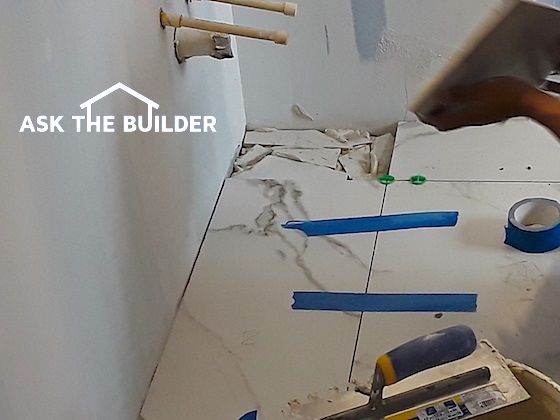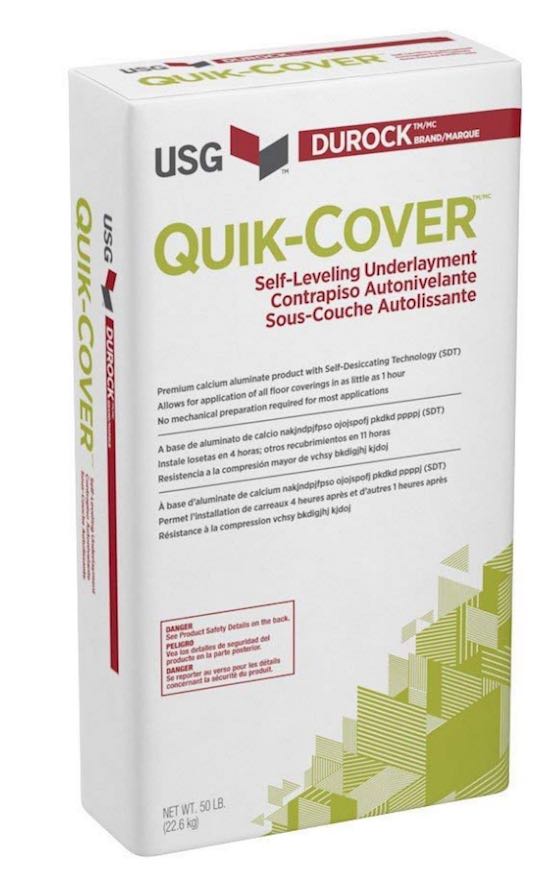Floor Leveling Compound / Ceramic Tile

Floor leveling compound should have been used on this job instead of broken pieces of marble. Can you believe the installer is doing this?? Copyright 2018 Tim Carter
"Before you mix up any compound always use the tools to see how deep the low spots are or how high the humps are."
Floor Leveling Compound Creates Perfect Flooring Jobs
Floor tiles - especially large ones - are very unforgiving if the floor beneath them has humps and dips. The same is true for just about any flooring material. It's best if the floor is in the same plane as is a piece of flat steel or glass laid on a table.
But wood floor systems and poured concrete are rarely in the same plane. Floor joists can have crowns in them that make the floor go up and down in both directions. Concrete is very hard to make perfectly smooth. Professional concrete masons struggle with this on a daily basis!
Related Links
How to Get Hardwood Floors Level
Floor Leveling Compound Brands - Get a Great One

This is a great easy-to-use floor leveling compound. You just add water and spread it around. CLICK THE IMAGE to have this delivered to your home.
Free & Fast Bids
How Do You Fill in Low Spots?
You can fill in dips and hollow spots in floors and reduce high spots by using cement-based floor leveling compounds. These will bond to both wood and concrete. They mix with water and are easy to apply. The key is practice and making sure you have the right tools.
What Tools Do You Use?
I install floor leveling compounds with my drywall broad knives and my framing square. The body of the framing square is 24 inches long and makes a superb straightedge when you hold it upright.
The drywall knives are perfect tools as well. Applying floor leveling compound is not much different than applying drywall compound over recessed seams. In fact, the challenge is identical. You want the floor leveling compound to just fill the recessed area and not be higher. If it ends up higher you now have created a hump!
Before you mix up any compound always use the tools to see how deep the low spots are or how high the humps are. Use a pencil to outline the areas to be filled. Pay attention to the airspace between the edge of the tools and the floor. This tells you the finished thickness of the material to be added.
Should the Floor Be Dust Free and Damp?
The area to be patched needs to be dust free and slightly damp. Taking the time to do this will yield huge results as the compound will really stick to the floor. Leveling compound failures can almost always be traced to dust or to dry subfloor conditions.
Use a vacuum cleaner to remove dust and a sponge mop to wet the floor. A regular sponge will do just fine to wet the floor. You will need a sponge and bucket of water handy as you install the floor leveling compound so you might as well get it ready now.
Should I Mix Small Amounts?
Mix small amounts until you have a feel for how the floor leveling compound works. There is a technique you must use to get professional results.
The floor leveling compounds set quickly! I mean quickly! Use cold water to try to slow it down. This does not always work. I can assure you that using hot water will make them set up even more rapidly if you need instant results.
Can I Add Water After Mixing?
NEVER re-temper or add water to floor leveling compound that has started to set up. This will weaken the final mix as you are tearing apart crystals in the mix that are growing and making it hard. These crystals - once broken - will not grow back. For this reason, it is always better to mix small, one gallon or fewer batches. Mixing up 2 or 3 gallons at once is suicide.
Mix the material so it has the consistency of thin pancake batter. It needs to be able to flow ever so slightly. You don't want it too thick or do you want it like water. If it is too thick it is nearly impossible to work with the tools.
How Do You Clean Up?
Clean everything with warm water and soap. All tools need to be cleaned as soon as you are done. If you use a cement based compound and you don't clean them, they will be almost impossible to clean the next day.
Author's Note: We've received other questions with similar problems or questions. Here's one from Krystina G. of San Sebastian, PR, dealing with floor levelness.
"My husband and I have a homemade completely out of cement and we want to put ceramic tiles throughout our home. The floor is not level and we wanted to know the best way to go on with leveling floors."
Column B365
3 Responses to Floor Leveling Compound / Ceramic Tile